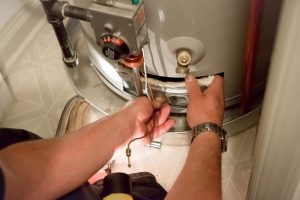 Water heaters–specifically tank water heaters, which are used in most homes in the area–usually do their jobs very quietly. Unlike furnaces or air conditioners, which typically show signs of trouble, water heaters rarely draw attention to themselves when there’s a problem. Add to that their typical placement in out-of-the-way locations in the home such as the basement, and problems have a way of spreading quite far before they are noticed. In most cases, that makes repair bills far more expensive than they might have been and can even merit the full-bore replacement of the water heater in order to contain the damage.
Water heaters–specifically tank water heaters, which are used in most homes in the area–usually do their jobs very quietly. Unlike furnaces or air conditioners, which typically show signs of trouble, water heaters rarely draw attention to themselves when there’s a problem. Add to that their typical placement in out-of-the-way locations in the home such as the basement, and problems have a way of spreading quite far before they are noticed. In most cases, that makes repair bills far more expensive than they might have been and can even merit the full-bore replacement of the water heater in order to contain the damage.
Preventative maintenance is vital to keeping water heater damage contained, and that starts with timely servicing from a trained plumber. It allows the plumber to check the unit for early signs of trouble and correct it before the damage advances. It also allows the plumber to do things like change the anode rod when it wears out to cut down on rust on the interior of the tank. When applied regularly over the course of time, it can even help extend the life of the water heater.
Beyond that, individual homeowners can take do-it-yourself steps to maintain the water heater and help it perform more effectively. That should include regularly flushing the tank out and refilling it. It takes only a few minutes, and the fall is a great time of the year to have it done, when the weather is mild and the deep freezes of winter are less of a concern.
What Does Flushing the Heater Do?
Water from municipal sources often contains trace amounts of sediment, which can settle in the bottom of the water heater tank. This forms an insulating barrier between the burners and the water they’re intended to warm. As a result, the system must work much harder to do its job, increasing stress and strain on individual components throughout the heater. This hits hardest on the bottom of the tank, which absorbs the heat blocked by the sediment and will eventually warp and rupture if the situation becomes too dire.
How to Flush the Water Heater
Removing the sediment from the bottom of the tank requires a periodic flushing, which can be accomplished in a few minutes. It requires only a garden hose and a receptacle to channel the water from the tank (ideally to a nearby drain, but a large bucket or the like will do as well). The steps for flushing the tank are as follows:
- Turn off the gas and electricity to the tank.
- Open a hot water faucet in a tub or sink in the home and let it run for ten minutes. This will cool off the water in the tank a bit.
- Turn off the water supply to the tank.
- Attach the hose to the tank’s drain valve and the other end to whatever receptacle is going to hold the water.
- Open the pressure valve in the top of the tank to start the flow of water. The water may move fast, so be ready.
- When the tank is drained and the sediment removed, turn the water back on.
- Close the pressure valve, the drain valve, and the open hot water tap in the home.
- Allow the tank to fill, then turn the gas and electricity back on.
For water heater maintenance throughout Scarsdale, NY, call on Yost & Campbell Heating, Cooling & Generators today!

